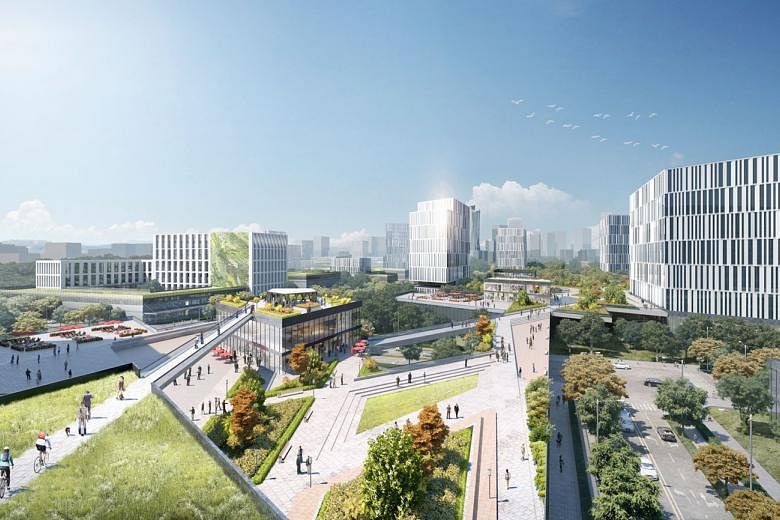The southern Malaysian region of Iskandar, which includes Johor Baru, is a classic example of the opportunities - and challenges - that come with the rapid urbanisation that is taking South-east Asian economies by storm.
Just across the border from Singapore, Iskandar's population is expected to double to three million people, from its 1.6 million currently, by 2025.
Cities all over South-east Asia - from Jakarta to Manila to Ho Chi Minh - are on a similar growth trajectory. Rapid urbanisation means that between 2015 and 2030, about 100 million people in Asean are expected to migrate from the countryside to cities.
While this is exciting from an economic point of view - urbanisation generally means improved productivity for companies, and better incomes and access to education, healthcare and transport for millions of ordinary citizens - the rapid growth of towns and cities also presents its own set of challenges. These range from congestion, crime, inequality and more expensive housing to environmental issues like pollution.
In South-east Asia, there is the extra complication that many cities are located in low-lying areas that are susceptible to rising sea levels and storms sweeping in from the oceans. And because cities are dense concentrations of businesses and households, consuming energy and goods, they contribute a large proportion of the greenhouse gas emissions that are causing global temperatures to rise.
Put all this together, and it is clear that the process of urbanisation must be handled wisely and "smartly".
Enter the concept of "smart cities".
This involves trying to integrate information and communications technologies to improve operations in everything from traffic flows and public transportation to energy and water usage in buildings and city neighbourhoods to healthcare services, for example, by improving or setting up electronic health records.
Done right, the smart use of data and digital technologies can significantly alleviate some of the challenges of urbanisation.
The good news is that Asean members are recognising the potential benefits that come with "smartening" cities.

For example, Thailand plans to transform its economy into a digitally powered ecosystem, and is aiming to create no less than 100 "smart cities" over the next two decades. Vietnam plans to introduce non-cash payments and put in place cashless payment devices or systems by 2020.
In Malaysia, Kuala Lumpur signed an agreement in January with Alibaba's cloud service, City Brain, to work on traffic management, town planning and incident response.
In the Philippines, the New Clark City development is envisioned as an alternative to the congested capital Manila. And Indonesia has 10 pilot cities adopting smart cards to distribute social assistance and provide integrated services.
But if the Asean integration ideal is to be realised, such individual country programmes need to be linked, and best practices and successes shared.
That is what makes the Asean Smart City Network (ASCN) - which includes regional capitals like Kuala Lumpur, Hanoi, Bangkok, Manila, Jakarta and Singapore, but also smaller cities like Johor Baru and Phuket - so important.
Agreed to at the Asean leaders' summit in Singapore late last month, the ASCN will be a platform for each of the region's countries to share best practices, link member cities with private investment and secure funding from multilateral funding institutions.
Through the network, the various Asean country initiatives will become greater than the sum of their parts, catapulting the region into the upper echelons of smart city advancements, globally.
The implications for this are manifold and extend beyond South-east Asia. Smart cities in general, and the ASCN in particular, will be fertile ground to cultivate and galvanise a lot of global collaboration around innovation.
One area of focus will be in smart mobility, particularly around electric vehicles and ride and car sharing. Another will be in connectivity of payments and trade digitisation.
This is encouraging an unprecedented level of cross-sector collaboration, with each sector bringing its expertise to form new ecosystems.
The ASCN will also help attract investment from outside the Asean region. Examples can be found already. In March, the Australian government pledged A$30 million (S$30.3 million) into Asean smart cities. And in June last year, the World Bank and the Swiss government established the US$13.4 million (S$18 million) Indonesia Sustainable Urbanisation Multi-Donor Trust Fund to ensure that the country's urbanisation process is economically, socially and environmentally sustainable.
Climate change and urbanisation are global phenomena, and smart cities' emphasis on innovative, sustainable technologies will create new opportunities for companies and investors and open up new avenues of investment - through sustainable financing - as projects and schemes are rolled out.
Smart technologies that can make city transportation, urban energy usage, building and waste management systems, and even healthcare more efficient (and therefore cleaner and more sustainable) will help alleviate the challenges that accompany the rapid expansion of towns and cities across Asia - from Johor Baru to Hanoi.
Smart cities will be good for citizens, good for business and good for the planet to boot. At its core, the focus is about seeking optimal business models for smart city development which will strike a balance between public good for the citizens and economic benefit for the private sector.
While success will not necessarily come easy, the formation of the ASCN is an excellent start. And governments, regulators, city planners and companies need to be on the right side of the innovation equation.
• Tony Cripps is the chief executive officer of HSBC Singapore.

